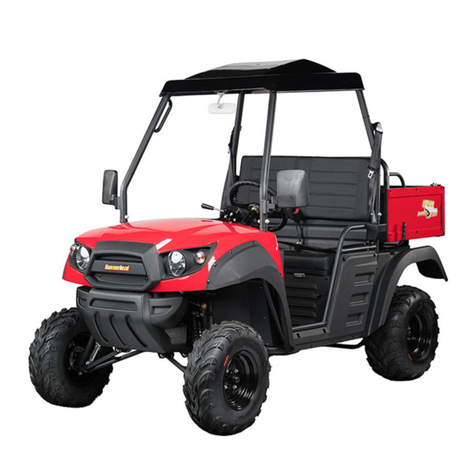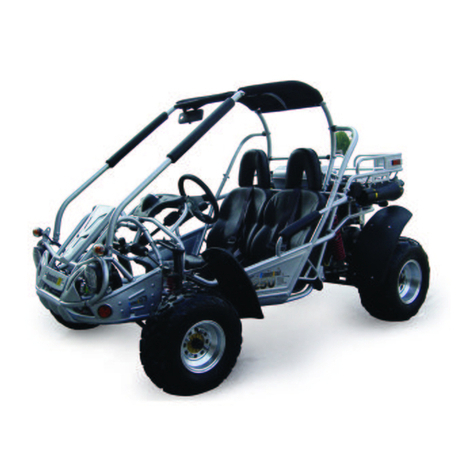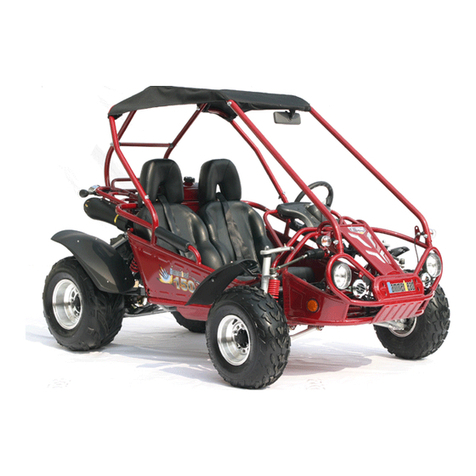OWNER' S MANUAL Page
1. FOREWORD ------------------------------------------------------------------------------------------ 1
2. A FEW WORDS ABOUT SAFETY ------------------------------------------------------------- 2
3. IMPORTANT SAFETY INFORMATION------------------------------------------------------- 3
4. SAFETY LABELS----------------------------------------------------------------------------------- 5
5. ARE YOU READY TO DRIVE?----------------------------------------------------------------- 6
6. IS YOUR VEHICLE READY TO DRIVE?----------------------------------------------------- 7
7. SAFE DRIVING PRECAUTIONS--------------------------------------------------------------- 8
8. P.D.I.---------------------------------------------------------------------------------------------------- 10
9. SPECIFICATIONS---------------------------------------------------------------------------------- 11
10. OPERATION---------------------------------------------------------------------------------------- 13
11. SERVICE INSTRUCTIONS--------------------------------------------------------------------- 17
12. REPAIR---------------------------------------------------------------------------------------------- 20
13. PERIODICAL CHECK AND SERVICES---------------------------------------------------- 23
14. WIRING DIAGRAM ------------------------------------------------------------------------------ 23
PARTS MANUAL Figure
1. CYLINDER COMP.--------------------------------------------------------------------------------- Fig. 1
2. CYLINDER COVER ASSY.(1)-------------------------------------------------------------------- Fig. 2
3. CYLINDER COVER ASSY.(2)-------------------------------------------------------------------- Fig. 3
4. CRANKCASE ASSY.------------------------------------------------------------------------------- Fig. 4
5. RIGHT SIDE COVER ASSY.--------------------------------------------------------------------- Fig. 5
6. CRANKSHAFT CON'ROD & PISTON ASSY.------------------------------------------------ Fig. 6
7. VALVE TRANNYASSY.(1)--------------------------------------------------------------------------Fig. 7
8. VALVE TRANNY ASSY.(2)------------------------------------------------------------------------ Fig. 8
9. LEFT SIDE COVER ASSY.----------------------------------------------------------------------- Fig. 9
10. WATER PUMP ASSY.---------------------------------------------------------------------------- Fig. 10
11. CARBURETOR COMP.--------------------------------------------------------------------------- Fig.11
12. OIL PUMP ASSY.---------------------------------------------------------------------------------- Fig.12
13. CLUTCH ASSY.------------------------------------------------------------------------------------ Fig. 13
14. ELECTRIC STARTER ASSY.------------------------------------------------------------------- Fig.14
15. REDUCTION BOX ASSY.----------------------------------------------------------------------- Fig.15
16. GEARBOX ASSY.--------------------------------------------------------------------------------- Fig.16
17. MAGNETO COMP.-------------------------------------------------------------------------------- Fig.17
18. FRAME GROUP----------------------------------------------------------------------------------- Fig.18
19. STEERING SHAFT ASSY.---------------------------------------------------------------------- Fig.19
20. FRONT SUSPENSION ARM ASSY----------------------------------------------------------- Fig.20
21. FULL SHIFTING ASSY.------------------------------------------------------------------------- Fig.21
22. REAR CARGO RACK/ SEAT/ BELT---------------------------------------------------------- Fig.22
23. AIR CLEANER/ RADIATOR/ BATTERY/ MUFFLER ASSY.---------------------------- Fig.23
24. GEAR BOX ASSY.-------------------------------------------------------------------------------- Fig.24
25. REAR SUSPENSION ASSY------------------------------------------------------------------- Fig.25
26. WIRE HARNESS/ELECTRICAL -------------------------------------------------------------- Fig.26
27. WARNING STICKERS -------------------------------------------------------------------------- Fig.27

































